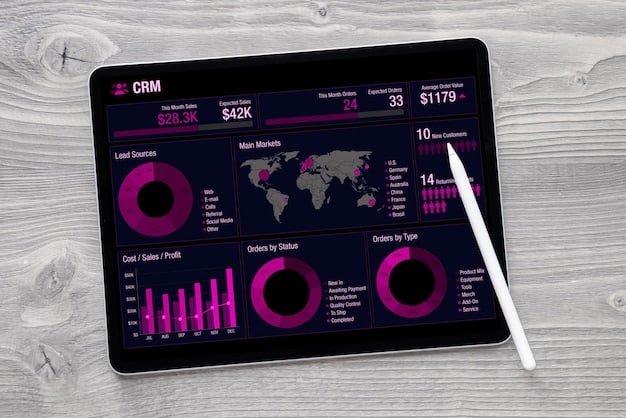Fintech Startup Marketing: Top 5 Strategies to Get First 1000 Customers

Fintech Startup Marketing: 5 Proven Strategies to Acquire Your First 1,000 Customers involves a tailored approach using content marketing, targeted advertising, strategic partnerships, referral programs, and community engagement to build brand awareness and drive initial customer acquisition.
Navigating the initial phases of a fintech startup requires a solid marketing plan. One of the biggest challenges is acquiring the first 1,000 customers. Here are Fintech Startup Marketing: 5 Proven Strategies to Acquire Your First 1,000 Customers.
Understanding Your Target Audience
Successful fintech startup marketing requires a thorough understanding of your target audience. Fintech solutions often solve complex problems, and it’s vital to know who you’re trying to reach.”
Start by identifying their needs, preferences, and behaviors. This will help you tailor your messaging and choose the right marketing channels.
Conduct Market Research
Market research is crucial for understanding your potential customers. Use surveys, interviews, and focus groups to gather insights.
Analyze demographic data, such as age, income, and location, to create detailed customer personas.
Create Customer Personas
Customer personas are fictional representations of your ideal customers. They help you visualize and understand your target audience.
Include details like their goals, challenges, and motivations.
- Identify your ideal customer’s pain points.
- Understand their financial behaviors.
- Determine their preferred communication channels.

Understanding your audience allows fintech startups to tailor advertising and content marketing efforts effectively, thus increasing the likelihood of successful customer acquisition.
Content Marketing for Fintech Startups
Content marketing empowers fintech startups to build trust and establish authority. By creating valuable content, you can attract and engage potential customers.
Focus on providing educational content that addresses common financial problems.
Create a Blog
A blog is a great way to share your expertise and connect with your audience. Write articles about industry trends, financial tips, and product updates.
Optimize your content for search engines to improve visibility.
Develop Ebooks and Whitepapers
Ebooks and whitepapers offer in-depth information on specific topics. These resources can be used to capture leads and build credibility.
Promote them through your website and social media channels.
- Offer practical financial advice.
- Explain complex concepts in simple terms.
- Showcase your expertise and thought leadership.
With content marketing, fintech startups build credibility and attract their first 1,000 customers, boosting long-term growth and demonstrating financial expertise.
Targeted Advertising Strategies
Targeted advertising allows you to reach the right audience with the right message. By focusing on specific demographics and interests, you can maximize your marketing budget.
Leverage platforms like Google Ads and social media to reach potential customers.
Use Google Ads
Google Ads can help you reach customers who are actively searching for financial solutions. Use relevant keywords and create compelling ad copy.
Track your results and adjust your campaigns based on performance.
Leverage Social Media Advertising
Platforms like Facebook, LinkedIn, and Twitter offer powerful targeting options. Use demographic, interest, and behavioral data to reach your ideal customers.
Create engaging ads that highlight the benefits of your fintech product.
- Define your target audience’s demographics and interests.
- Create ads that address their specific needs.
- Track and optimize your campaigns for the best results.

Effective targeted advertising connects fintech startups with potential customers seeking financial solutions. Combined with analytics and optimization, this converts prospects and drives sustainable growth.
Strategic Partnerships and Collaborations
Strategic partnerships can significantly expand your reach. By collaborating with complementary businesses, you can tap into new customer bases.
Look for opportunities to partner with banks, financial advisors, and other fintech companies.
Partner with Banks and Credit Unions
Banks and credit unions can provide access to a large customer base. Offer them a co-branded solution or integrate your product into their services.
This can provide instant credibility and accelerate customer acquisition.
Collaborate with Financial Advisors
Financial advisors can recommend your product to their clients. Provide them with training and support to ensure they understand the benefits of your solution.
This can drive targeted referrals and build trust.
- Identify potential partners with a complementary customer base.
- Create mutually beneficial partnerships that drive value.
- Provide training and support to your partners.
Ultimately, strategic partnerships drive customer acquisition and reinforce marketplace credibility.
Implementing Referral Programs
Referral programs reward existing customers for referring new ones. This can be a cost-effective way to acquire new customers and build brand loyalty.
Design a referral program that incentivizes both the referrer and the referee.
Offer Attractive Rewards
Provide rewards that are valuable to your customers. This could include discounts, free trials, or cash bonuses.
Make the rewards compelling enough to encourage participation.
Make it Easy to Refer
Simplify the referral process by providing pre-written emails or social media posts. Make it easy for customers to share your product with their network.
The easier it is, the more likely they are to participate.
- Design a referral program that is easy to understand.
- Offer compelling rewards for both referrer and referee.
- Promote your referral program through multiple channels.
Well-designed incentive programs enhance customer engagement and build a dedicated user base, accelerating adoption. Referral programs expand the brand’s presence and increase its growth potential.
Community Engagement and Social Presence
Engaging with your community helps build trust and brand loyalty. By being active on social media and participating in industry events, you can connect with potential customers and establish thought leadership.
Share valuable content, respond to comments, and participate in relevant discussions.
Be Active on Social Media
Choose the social media platforms that your target audience uses most. Share your content, engage with your followers, and run targeted ads.
Use social media to build relationships and foster a sense of community.
Attend Industry Events
Industry events provide opportunities to network with potential customers and partners. Participate in conferences, webinars, and workshops.
This can help you build relationships and establish your brand.
- Identify relevant community engagement opportunities.
- Participate in industry events and webinars.
- Engage with your audience on social media platforms.
| Key Point | Brief Description |
|---|---|
| 🎯 Understand Your Audience | Identify customer needs through market research and personas. |
| ✍️ Content Marketing | Create blogs, ebooks, and whitepapers to build trust. |
| 📢 Targeted Advertising | Use Google Ads and social media to reach specific demographics. |
| 🤝 Strategic Partnerships | Collaborate with banks, advisors, and other fintechs. |
FAQ
▼
Identifying your fintech startup’s target audience is key to growth and enables you to concentrate your resources and marketing initiatives on the demographics that are most amenable to your services.
▼
Fintech firms may successfully connect with target consumers and exhibit thought leadership by utilizing social media channels for content distribution, community involvement, and focused advertising campaigns.
▼
Referral programs benefit fintech companies by incentivizing current customers to successfully refer new ones, encouraging organic development and expanding brand reach.
▼
Companies may achieve a deep grasp of their potential customers, their financial behaviors, and the competitive environment in the fintech sector by doing thorough market research, which informs strategy and innovation.
▼
When aiming to reach the right fintech consumer, Google Ads are essential for directing potential traffic to a website or special offer since they are a tool for precisely targeting advertising expenditure to target certain groups.
Conclusion
Successfully acquiring your first 1,000 customers as a fintech startup requires a holistic approach. By understanding your audience, leveraging content, targeting your advertising, forming strategic partnerships, implementing referral programs, and engaging with your community, you can lay a solid foundation for growth. These fintech startup marketing strategies, when executed effectively, will drive customer acquisition and establish your brand in the competitive fintech landscape.





